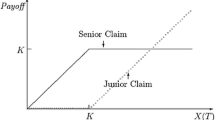Abstract
Empirical findings are mixed about the performance of structural models for term structure of credit spreads. It is commonly believed that all structural models have equally poor performance after calibration. However, proper calibration is not a trivial issue, especially for highly structural models. This paper proposes a more accurate procedure for calibrating two models: Leland–Toft (J Finance 51:987–1019, 1996) and Collin-Dufresne and Goldstein (J Finance 56:2177–2208, 2001). Using rating-based bond data, we find that the Leland–Toft model has significantly greater explanatory power for credit spreads across rating categories than previously reported. We provide theoretical explanations for these findings, and further extend our empirical analysis to include 286 individual senior bonds. Our findings help clarify the controversies over the performance of structural models in general and that of the Leland–Toft model in particular. In addition, we offer a rigorous procedure that can be used for calibrating other structural models more effectively.
Similar content being viewed by others
References
Andrade G. and Kaplan S. (1998). How costly is financial (not economic) distress? Evidence from highly levered transactions that became distressed. J Finance 53: 1443–1493
Bhandari C. (1988). Debt/equity ratio and expected common stock returns: Empirical evidence. J Finance 43: 507–528
Black F. and Cox J. (1976). Valuing corporate securities: Some effects of bond indenture provisions. J Finance 31: 351–367
Brealey R.A. and Myers S.C. (1996). Principles of Corporate Finance, 5th edn. The McGraw-Hill Companies, Inc., New York
Brennan M. and Schwartz E. (1978). Corporate income taxes, valuation and the problem of optimal capital structure. J Bus 51: 103–114
Caouette J.B., Altman E.I. and Narayanan P. (1998). Managing Credit Risk: the Next Great Financial Challenge. Wiley, New York
Collin-Dufresne P. and Goldstein R.S. (2001). Do credit spreads reflect stationary leverage ratios?. J Finance 56: 2177–2208
Collin-Dufresne P., Goldstein R.S. and Martin J.S. (2001). The determinants of credit spread changes. J Finance 56: 2177–2207
Elton E.J., Gruber M.J., Agrawal D. and Mann C. (2001). Explaining the rate spread on corporate bonds. J Finance 56: 247–276
Eom Y.H., Helwege J. and Huang J.-Z. (2003). Structural models of corporate bond pricing: An empirical analysis. Rev Financ Stud 17: 499–544
Fons J. (1994). Using default rates to model the term structure of credit risk. Financial Anal J September–October: 25–32
Hackbarth D., Hennessy C.A. and Leland H.E. (2007). Can the trade-off theory explain debt structure?. Rev Financ Stud 20: 1389–1428
Hittle L.C., Haddad K. and Gitman L.J. (1992). Over-the-counter firms, asymmetric information and financing preferences. Rev Financ Econ 2(1): 81–92
Huang, J.-Z., Huang, M.: How much of the corporate-Treasury yield spread is due to credit risk? working paper, Penn State and Stanford Universities (2003)
Jones E.P., Mason S. and Rosenfeld E. (1984). Contingent claims analysis of corporate capital structures: An empirical investigation. J Finance 39: 611–625
Leland H. (1994). Corporate debt value, bond covenants and optional capital structure. J Finance 49: 1213–1252
Leland H. and Toft K. (1996). Optimal capital structure, endogenous bankruptcy and the term structure of credit spreads. J Finance 51: 987–1019
Longstaff F. and Schwartz E. (1995). A simple approach to valuing risky fixed and floating rate debt. J Finance 50: 789–891
Merton R. (1974). On the pricing of corporate debt: The risk structure of interest rates. J Finance 29: 449–470
Miller M. (1977). Debt and taxes. J Finance 32: 261–275
Myers S.C. (1984). The capital structure puzzle. J Finance 39: 575–592
Myers S.C. (1993). Still searching for optimal capital structure. J Appl Corporate Finance 39: 4–14
Pinegar J.M. and Wilbricht L. (1989). What managers think of capital structure theory: A survey. Financ Manage Winter: 82–91
Shiller R. (1981). Do stock prices move too much to be justified by subsequent changes in dividends?. Am Econ Rev 71: 421–436
Author information
Authors and Affiliations
Corresponding author
Rights and permissions
About this article
Cite this article
Qi, H., Liu, S. & Wu, C. On the calibration of structural credit spread models. Ann Finance 5, 189–208 (2009). https://doi.org/10.1007/s10436-008-0097-3
Received:
Accepted:
Published:
Issue Date:
DOI: https://doi.org/10.1007/s10436-008-0097-3




